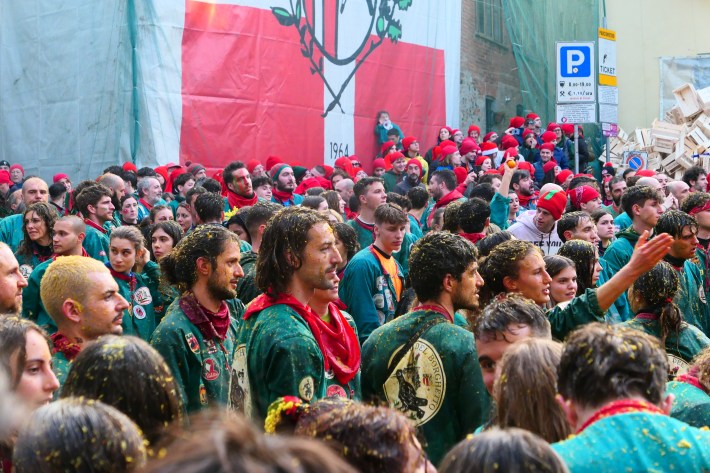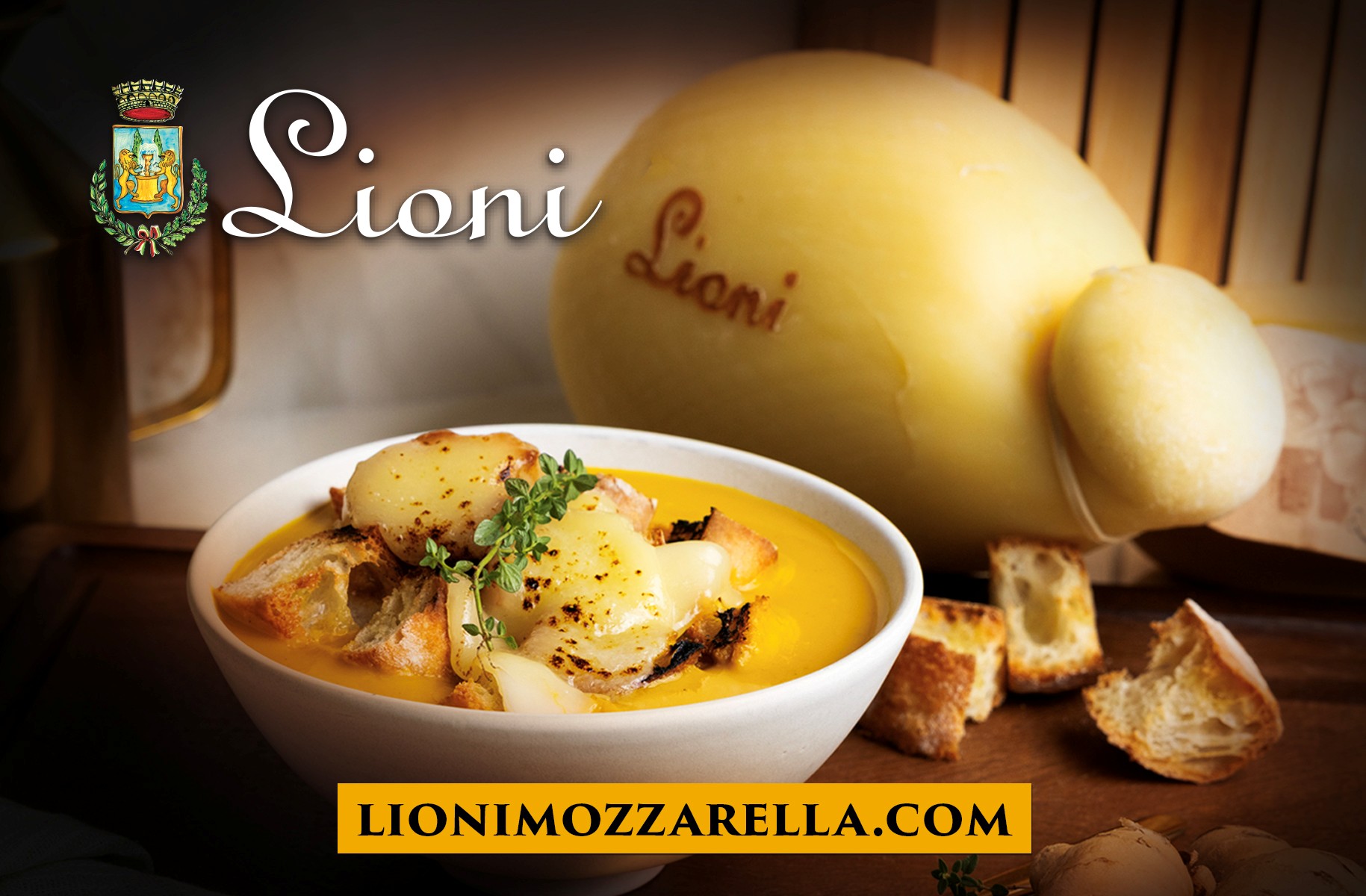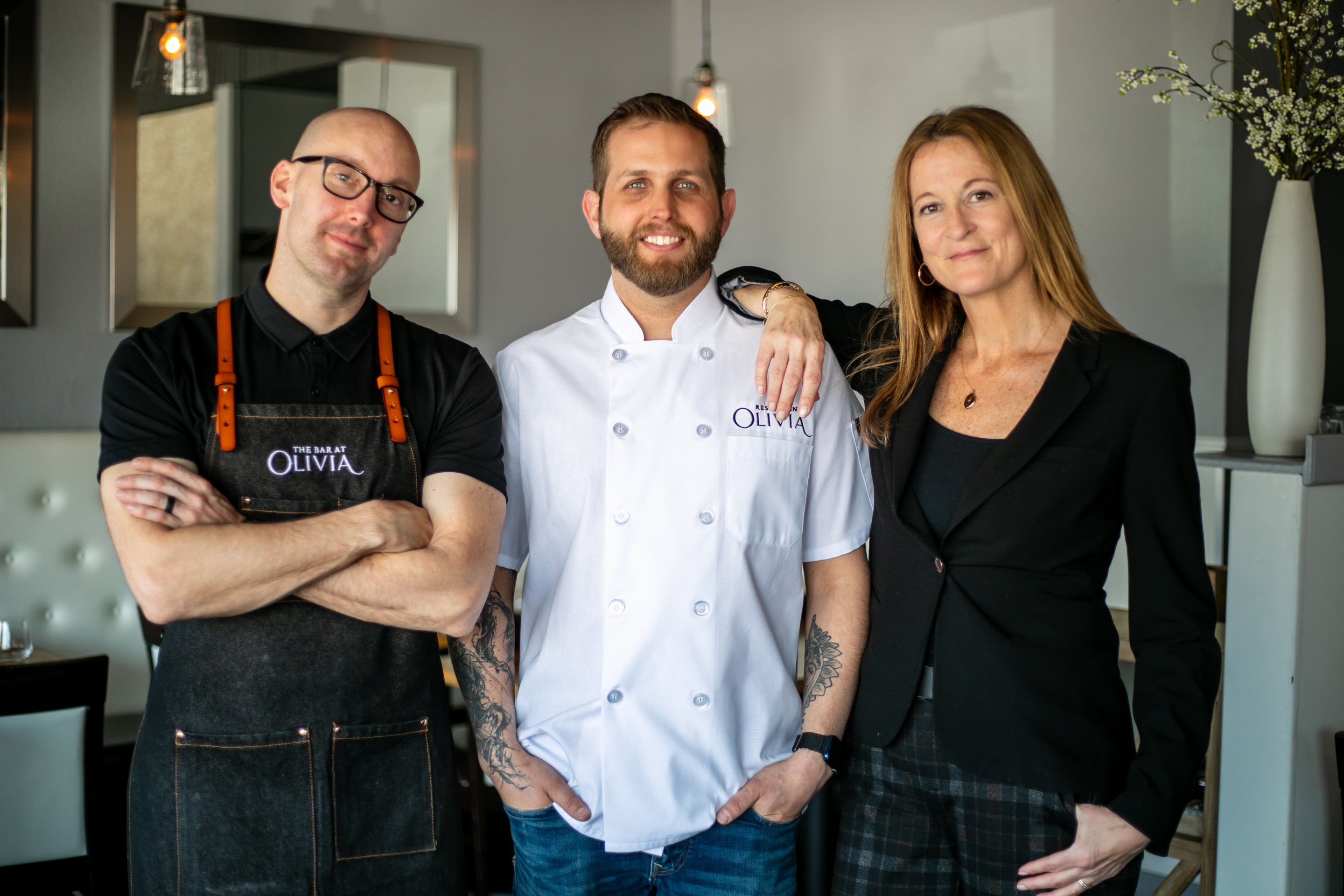Carnevale, the period before Lent, brings debaucherous festivals and extravagant seasonal treats to the country of indulgence. The name was likely taken from the Latin phrase "carnem levare," which means removing meat from one's diet during the lent season. Ivrea, a town in the northwestern region of Piemonte, is particularly famous for its unique celebration. A citrusy siege takes over the city for three days as Ivreans turn the clock back to medieval times.
I was lucky to follow the historic Tuchini Arancieri (orange throwing team) throughout the week. Though the thousand-plus-person food fight usually steals the show, I left feeling that the true heart of this celebration is found beyond the streets of mushed oranges. Locals play different characters, feasts are held, royal parades follow course, and everyone plays their role. Carnevale in Ivrea is a prime display of Italian culture's emphasis on community. Everyone leans in and does their part. What ensues is an entertaining and well-produced celebration. The tradition honors the story of the Mugnaia and a town that came together against tyranny. And perhaps it helps that everything about the week is a sugary-sweet indulgence.
The Legend
Once upon a time, an evil marquis kidnapped and defiled the soon-to-be newlyweds of Ivrea the night before each of their weddings. One courageous woman, Violetta, known as La Mugnaia, sliced off his head. The following morning, she stepped out onto her balcony, severed head in hand. Chaos ensued, and a fight broke out between the Marquis' soldiers and citizens, finally revolting against the oppressive regime they had lived under for too long. Or so it's told…
The first documented account of Carnevale, written in 1858, long after the beginnings of Carnevale in Ivrea, states that the festival's intent is "not a vulgar amusement, but the celebration of a sublime victory." It emphasizes the importance of learning the past to avoid making the same mistakes in the future, thus the complete re-enactment.
Every year, a new woman from the town is selected as La Mugnaia. A general, the town royals, and all ranks of medieval government officials are also chosen and outfitted for the part. The Marquis's knights board horses and carriages. Oranges are thrown, and the legend lives on.

The whole celebration, though, contains many Ivrean traditions layered together. The Abba, a hand-selected group of children, plays a large part in the week's events. In the photo above, they're visiting the Fagiolata, who organize the feast of the beans. On the back wall, you can see photos of the Mugnaie and Generals from years past. It's hard to imagine just how seriously this is all taken. When the Mugnaia is revealed individually to each team, Whatsapp messages of her identity are shot around the city like wildfire, and it's not uncommon for tears to be shed during her debut. The commitment to all parts of Carnevale makes the week so uniquely special.
Upon arrival to the city, one of the many eager Ivreans will hand you a guide outlining the weeks' worth of events. There is something to do nearly all hours of the day, and all ages are welcome. Every event weaves together the story of Ivrea and replicates that impassioned feeling of freedom and fun, the proper basis for any Carnevale event worth a visit.
Giovedi Grasso
"Fat Thursday" is the night when chaos properly kicks off Carnevale in Ivrea. For weeks, the Ivreans have been working on crafting the perfect costume. Likely homemade, everything from trash cans to Tetris. Energy envelops the town. Around each corner, a new marching band appears. Team anthems are sung. Bombardini makes its rounds and, as expected from the name of the night, decadent desserts are devoured.
Each team has its own welcome party, to which both the observer and opponent are invited. Later, the parties bleed into each other, and the city becomes one large celebration. Kids set bets on whose team will win this year, and rumors fly about the identity of the Mugnaia. The town is brimming with anticipation for the next few days as best friends spend a final night celebrating together before they prepare to join enemy teams.
Feasts
Perhaps your role is not orange thrower or pseudo-aristocracy. Even in the days of old, you were a do-gooder. You likely work with the Fagiolata Benefica di Castellazzo. Originally managed by the church, the organization hosts charitable banquets for the poor and feasts during saints' days. On the third night of Carnevale, the air suddenly becomes choked with the fragrance of burning timber and rosemary bushes. If you follow the scent and plumes of smoke, you'll get to witness the members of the Fagiolata lighting the ten pots, which will cook 6,000 liters of beans, pork rind, and a unique herb mix all through the night. Around 4 a.m., late-night partiers will line up throughout the courtyard in which the headquarters of the Fagiolata sits, awaiting a small helping of beans to soothe their stomachs. The following morning, the nearest piazza is boiling over with people.

Through curiosity and gluttony, I found myself taken in by the Fagiolata. I witnessed men cleaning more beans than I ever thought I'd see. They shared the history with me and, of course, the surprisingly intensely flavorful beans, since they were cooked in a 600-liter pot.
Opening Parade
Generals, townsfolk, pied pipers, and selections from each team file through piazzas and throughout the whole city. This is the night the townspeople learn the identity of their beloved Mugnaia. Cheers and tears commence for the Mugnaia and all that she represents. Fireworks initiated the proper start of the Orange Wars.

A constant throughout the weekend is the parades. Many legions, musicians, and chosen aristocracy parade through each team's piazza. They wave at us mock peasants as we cheer from the crowd. The amount of young people who have mastered ancient skills like flag tossing and playing the pipe is astounding. The aforementioned children of the Abba ride ponies and raise swords stabbed with oranges. They're followed by pied pipers and local representatives from the surrounding areas. Jugglers, generals, and everything in between pass through the parting of the crowds. Being present and part of the parade is, for most, the whole role itself. Lacking any real aristocratic or government power, their role is as an actor in tribute to the town. That, in itself, is one of the highest honors. The sounds of the horses trotting and instrumental renditions of 2010's hottest music ring through the air. Cheers for the darling Mugnaia and team chants compete for prominence. The parades are communal moments that break up the carnage of the orange fights. Moments to remember the history and honor each other's commitment to the festivities.
Orange Battle
The piece de resistance, literally, is, of course, the orange fight against tyranny. Though I've found the soul of Carnevale in the week's surrounding event, I'd be remiss if I didn't mention the beating heart that is the Orange Wars. Ivrea has faced backlash in their continuation of a tradition that could, skeptically, be viewed as wasteful, silly, moderately injury-inducing, and abusive towards horses. The city and its inhabitants adamantly rebuke these sentiments. I'm happy to report that the oranges the town receives are unsellable. Usually mushy, deformed, occasionally moldy. The horses are largely avoided in the battles as everyone there is also concerned with their well-being, this not being a real war and all. Black eyes, bloody noses, and all injuries are shown with pride by their Arancieri. Some even go as far as to use the blood orange juice to imitate bleeding wounds in display of their ferocity. And lastly, the silliness of everything is the point. It's about letting loose and living in a world that's utterly unreal for a week. Airing a bit of frustration in a state-sanctioned way adds to the fun as well. Tradition is paramount in Italy. Their past is integrated into their present in almost everything they do.

You might think it's excessive, but there are three days of orange fights. The arancieri roll out of bed each day, bruised from the prior day's battle and likely a bit worse for wear from the celebrations late into each night. Official jerseys and team colors instantly go on, and around 1 p.m., they are ready to fight tyranny again, aided by the ever-flowing tanks of vin brûlée which line the town squares. The team organizers make lunch for everyone, as, of course, an Italian must not skip a meal of pasta, for how will they get their power to fight? Court-jester-style pouches are filled with oranges as a procession of the Marquis's knights enter the piazza one by one. They carry directly down the corridor as the peasants channel everything they have into the orange attack. A break, some more vin brûlée, and after about thirty minutes, they carry on again. This goes on for many hours until the orange waste is nearly knee-deep, and each individual is properly saturated with pulp. On the final day, the sadness is palpable. A deluge of oranges is thrown into the air like graduation caps, toasting to the end of something great.

As the knights shed their armor and the local government takes over from the aristocracy, the vibrant spirit of community becomes even more evident. The uniquely Ivrean tradition may have come to an end, but the absurd camaraderie remains tangible in the streets long after the final bonfire is lit. There can be an endless amount of think pieces written about the ethicality or necessity of all this, but ultimately, tradition and fun win out.
Here, mouths are fed, bellies are full, and tyranny is conquered. I left with a fuller heart, all my teeth (luckily), and perhaps a few less brain cells from all the revelry, but richer in the experience of togetherness.







